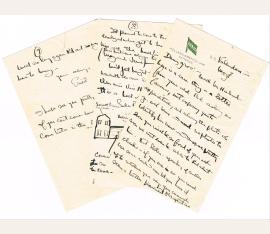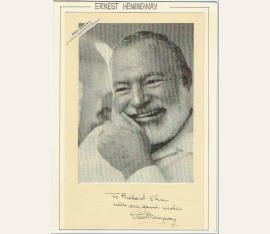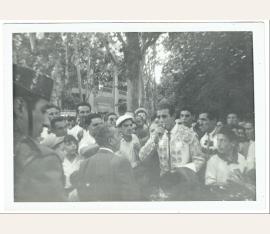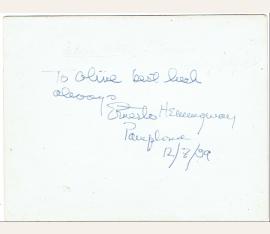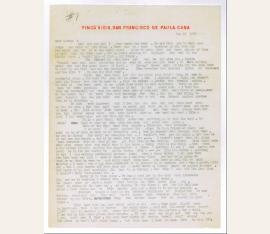American novelist, Nobel laureate (1899-1961). Exceptional group of four letters from Hemingway to his close friend Guy Hickok. France, Spain, the Bahamas, Cuba, and aboard the S.S. Volendam of the Holland-America Line. 4to and 8vo. 18 pages.
48.000 €
(47476)
Exceptional group of four letters from Hemingway to his close friend Guy Hickok, comprising one ALS, two partial autograph letters, and a one-page TLS. The longest ALS, signed “Ernest,” nine pages on five sheets, May 7, [1931], was written aboard the S.S. Volendam of the Holland-America Line. In part: “When my kidney was being weird had to give up drinking for about 6 weeks but now can drink and have drunk for ever since a year ago last February—I may have made a certain amt. of dough which has all been give away, loaned or spent but I am a son of a bitch if I have become respectable and no later than last winter was forced to sleep all night on the front porch—not being a good size for Pauline to carry up stairs—and on going to church the next morning was supposed to be healed…just because I had bumped into the holy water fount, that I saw the car was standing with the top down and the 3/4 empty bottle very visible (it had been invisible in the dark) in front of the church with the French nameplate to identify it! Don’t want to claim to be a drunk like you but have not become respectable Gros—The reason I didn't write you about the book is because it is hard enough to write it without writing about it.
But listen if you will come down to Madrid you can read it typed…besides which we could see who can drink and who not and see the bullfights—The dope is this…will go to Madrid and work like a bastard on this book until finished—Have 280 some pages done—most to be written over and 1/3 or more to be added—I think you’ll like the damn book.” He goes on to discuss his travel plans and the repayment of a loan, before discussing an arm injury suffered in Montana: “I couldn't write then because my arm was still paralyzed. Have only been able to write since 3 weeks. It will be absolutely all right if keep after it. Anyway can shoot, fish and write with it now, but can't sock anybody.” Here, he sketches a diagram of his arm’s range of motion. Hemingway also provides a sketch of his new home in Key West, pointing out his favorite features, including a “flat roof, see all over town and sea.” The second, a partial autograph letter in pencil, unsigned, one page both sides, June 18, [1935], in part: “Listen stupid when you get in a money jam why in hell don’t let me know?…God dammit I was always suspicious of that Syndicate job…Gingrich of Esquire is coming here July 3-6 to fish and I will talk to him about your staff.” The third, a partial autograph letter in pencil, signed “Ernest” and “E. Hemingway [within his address],” one page, no date, in part: “Address here is E. Hemingway, c/o Captain George D. Kreidt, 1437 S.W. 5th Street, Miami, he brings mail on pilot boat once a week. Just got Mary’s letter last night. Don’t be afraid to cash this check as have 438 in bank by latest statement. Also 1000 coming in on July 1.” The fourth, a TLS signed in pencil, “Hemingstein,” one page, no date, in part: “It was swell to hear from you and thanks the hell of a lot for sending me the 100 bucks. I appreciate it like hell and know how damned hard it is to get money together in chunks as big as that. It came in damned handy because have been writing on this novel since last March First and during that time make no dough. Had seventy four bucks in my bank account when got your hundred.” At the conclusion, Hemingway jots down his Cuban address: “Address, Hotel Ambos Mundos, Havana—Cuba.” Also includes three letters in another hand (apparently dictated by Hemingway) as well as one unsigned typed letter, frequently referencing loans between the two. In overall very good to fine condition, with tears to the bottom of the typed letter. A young Ernest Hemingway first met the recipient of these letters, Guy Hickok (addressed here as “Gros”) in the early 1920s when they were both acting as foreign correspondents for North American newspapers in Paris. Hemingway, working for the Toronto Star, began what would become an enduring friendship with the good-natured Hickok, who was on assignment for the Brooklyn Daily Eagle. Hickok even provided the inspiration for Hemingway's short story ‘Che Ti Dice La Patria?’ (collected in Men Without Women, 1927). This fabulous correspondence is congenial, unrestrained, and mildly profane, and lends tremendous insight into Hemingway’s life and work..
Schriftsteller und Nobelpreisträger (1899–1961). Eigenh. Albumblatt geschrieben unterhalb seines Portrait mit Unterschrift. ohne Ort und Datum [um 1954]. 295 : 210 mm (Trägerkarton).
3.500 €
(83374)
Das montierte Porträt stammt aus dem Life Magazine vom 8. November 1954, das sich auf acht Seiten dem gerade gekürten Literaturnobelpreisträger desselben Jahres widmete. Das ikonische Photo wurde von Leonard McCombe in Hemingways kubanischem Domizil aufgenommen. – Die obere rechte Ecke des Trägerkartons leicht knickspurig.
American novelist, Nobel laureate (1899-1961). Signed and inscribed photograph (on the verso of a bullfighter’s image). Pamplona. 125 : 90 mm.
8.500 €
(93497)
A privately taken photograph of Hemingway (105 : 75 mm) at Pamplona with English visitors Olive and Doreen Mills, unsigned. All three smiling at the photographer’s lense. There is a photograph of the Spanish bullfighter Antonio Ordóñez surrounded by a group of people. This photograph is signed, inscribed, and dated by Hemingway: „To Doreen with all good wishes always | Ernesto Hemingway | Pamplona | 12/7/59“. Hemingway visited Pamplona eight times between 1924-1959 and he stayed on his last visit to Pamplona from July 7-14, 1959. Included is also a photograph showing Antonio Ordóñez, the famous Spanish bullfighter, signed, inscribed on the image.
Ordóñez met a number of writers and actors, and he also starred in a few films. Antonio was a long time friend of Ernest Hemingway, whom he called Father Ernesto. Hemingway wrote an account of Ordóñez's rivalry with the matador Luis Miguel Dominguín (also Ordóñez's brother-in-law) titled The Dangerous Summer..
American novelist, Nobel laureate (1899-1961). Signed and inscribed photograph (on the verso of a bullfighter’s image). Pamplona. 114 : 88 mm.
7.500 €
(93498)
A privately taken photograph of Hemingway (75 : 105 mm) at Pamplona with English visitors Olive and Doreen Mills, unsigned. All three smiling at the photographer’s lense. There is a photograph of the Spanish bullfighter Antonio Ordóñez surrounded by a group of people. This photograph is signed, inscribed, and dated by Hemingway: „To Olive | always | Ernesto Hemingway | Pamplona | 12/7/59“. Hemingway visited Pamplona eight times between 1924-1959 and he stayed on his last visit to Pamplona from July 7-14, 1959. Ordóñez met a number of writers and actors, and he also starred in a few films.
Antonio was a long time friend of Ernest Hemingway, whom he called Father Ernesto. Hemingway wrote an account of Ordóñez's rivalry with the matador Luis Miguel Dominguín (also Ordóñez's brother-in-law) titled The Dangerous Summer..
American novelist, Nobel laureate (1899-1961). Collection of 2 typed letters (1 with some autograph lines, both signed ("Ernie"). San Francisco de Paula (Cuba). Large 4to. Altogether 2½ pp. on 3 pp. With one autogr. envelope.
12.500 €
(44185/BN30219)
To George Brown, the owner of a gymnasium in Manhattan, Hemingway's personal trainer, boxing coach, and friend. - I: Hemingway's affection for his sporting pal is evident in this revealing and highly personal letter, written shortly before Ernest and Mary left for an African safari: "How are you kid? Mary sends her best. We are fine and in very good shape and think of you often. Were out on a trip together on the boat for two weeks and we go to bed every night after it gets dark and have plenty of time to talk and to sleep good [...]".
Hemingway then gives news of his sons, and mentions his youngest son ("Gig"), who, in his early twenties, was turning violently hostile to his father: "I am sorry I spoke against Gig since he is a friend of yours and used to be of mine as well as my favorite son. But he changed very strange very fast. As bad as though the devil was managing him. I couldn't ever see him again; not even to go and see him hanged. But if he seems good to you, O.K. I haven't heard from him since last November when he came of age [...]" (Finca Vigia, San Francisco de Paula, Cuba, May 12, 1953). - II: Written from his sickbed. Preparations were still being made for the film mentioned above, and Hemingway had spent September trying to get actions shots of leaping marlins for the producer Leland Hayward. Apparently, too, Hemingway was making an effort to get Brown involved in getting Spencer Tracy in shape, for he writes: "I am very sorry about [Peter] Viertel [wrote the screenplay] behaving so carelessly. He is a very selfish boy but I think he has a little bit of an excuse in that he was with Zinneman on the script and was expecting you out there. While Zinneman was down here we discussed the whole thing about your getting Spencer in shape and agreed it was absolutely necessary and we spoke about it again on the long distance phone […]" (ibid., November 25, 1955; with several autogr. lines in pencil). - On personal stationery of Finca Vigia. - Partly light-soiled, otherwise in fine condition..

Schriftsteller und Nobelpreisträger (1899–1961). Eigenh. Widmung und Unterschrift in: „The Old Man And The Sea“. Charles Scribner’s Sons, New York, 1952. Havana. 8vo.
8.500 €
(89376)
Spätere Ausgabe des bedeutenden Werkes mit eigenh. Widmung „For Karl Karlsson | remembering a happy meeting on ,Vretaholm’ Best always Ernest Hemingway Havana 1955.“ Der Umschlag mit deutlichen Gebrauchsspuren und Einrissen. Als Hemingway 1954 der Literaturnobelpreis verliehen wurde, konnte er aufgrund von Verletzungen nach einem Flugzeugabsturz nicht nach Stockholm kommen, um den Preis entgegenzunehmen. Im Januar 1955 wurde Hemingway daher auf Initiative des Reeders Tor Erland Broström zu einem verspäteten Nobelpreis-Mittagessen auf dem Schiff M/S Vretaholm eingeladen, das in Havanna ankerte.
Etwa 20 Gäste waren bei dem dreistündigen Mittagessen anwesend. Für das Essen sorgte Chefsteward Karl „Kalle“ Karlsson aus Halmstad, der am nächsten Tag von Hemingways Sekretärin Hemingways eigenes Exemplar von „Der alte Mann und das Meer“ mit einer schönen Widmung als Geschenk überreicht bekam..
verkauft
Eigenh. Albumblatt mit U.
Autograph ist nicht mehr verfügbar
"To Richard Ehm | with all good wishes". – Mit alt montiertem Portrait (Zeitungsausschnitt).
Autograph letter signed ("Ernie").
Autograph ist nicht mehr verfügbar
To George Brown, the owner of a gymnasium in Manhattan, Hemingway's personal trainer, boxing coach, and friend. In early 1954 Ernest and Mary Hemingway suffered two near-fatal plane crashes in Uganda, and Hemingway's injuries were extensive. According to Carlos Baker, "The crash at Butiaba and the fire at Shimoni had [...] left him no more than a shadow of his former vigor […]". - "Just got your letter of Jan 14 George forwarded back from Nairobi. Sure glad you liked the first hooks piece with the pictures. We'd only been out 4-5 weeks then and I wasn't really in shape. In 5 months of that stuff got down to under 190 before those crashes. Now no exercise since Jan 23-24th except early necessary damaging exercise (pitching rocks left-handed with a busted back type of exercise). Good thing I was in shape though. All doctors look at you like some kind of freak like Joe Grimm because you are alive. Am tired of being so smashed up. But always remember you and your head. We beat this one I guess but the smashed vertebrae etc is a no good rap […]" ([Madrid], May 24, 1954).
Typescript letter signed ("Ernest Hemingway") with autograph corrections and postscript.
Autograph ist nicht mehr verfügbar
Important, unpublished letter to the leftist activist and writer Abner Green in New York, remarking on American literary circles and the use of advocating against fascism: "[...] But one thing you don't need to worry about is the way the boys think I'm lousy. If you are ever very popular you will be very unpopular sooner or later. Only one thing will avoid that and that is devoting your live [!] to being popular or being fashionable [autograph insertion: 'ie., Galsworthy - Lewis right now I think - maybe wrong'] and that means that you won't do anything worth a damn and will stink as soon as your are dead. I've insulted all the bastards who make and keep your ['fame', stricken out and corrected to:] reputation while you are doing it so I do not have to carry that as an added weight and have only my stuff to devote myself too [!]. As long as I can write will always be popular again sooner or later whether want to or not. What the boys say is what is fashionable. Hell I was fashionable as you want but when it was going on I stayed away from the country and never saw anybody that read my stuff. They don't really care anything about writing and they know nothing about it. Right now if I could write Hamlet the Marxian slanted critics would say it was lousy. But if I came out as a communist I could write straight shit slanted and they would say it was marvellous and world moving epochistic [...] It's funny though how literary people hate fishing and shooting. They also hate kidding. If you kid that means you can't really be any good because they wouldn't kid because that would mean a loss of their dignity [...] I was talking with Jack Lawson (John Howard Lawson) and I was kidding about suicide, making some joke about it and he walked out of the room announcing his brother committed suicide and he would hear no jokes about it. Well so had my old man and plenty of others in the family. What was this starting to prove? Oh yes you mustn't make jokes if you are a serious writer. I think you slipped on the Malady of Power piece. That was meant to reach people that the other one wouldn't; the people who if they saw a serious piece by me wouldn't read it. They sold 50,000 copies of that notes on the next war in Hungary in pamphlet form. The piece on Wings Over Africa will raise plenty hell there too and will do plenty of damage smuggled into Italy as a pamphlet. What's better? To do that? Or sit around with Sidney Kingsley, Clifford Odets, Archibald MacLeish and Genevieve Taggard at a restaurant and discuss steps we must take against War and Fascism? Well lets not get into that. The difference is that if you go to the meetings and put your name on the letterheads you are fashionable and if you do your goddamndest against War and Fascism knowing what both of them are and haveing [!] seen plenty of both and how to hit them where they hurt and keep on trying to do it why you are a shit who writes [inserted: 'rubbish'] for the Men's Clothing Trade Journal [... ]". - In the autograph postscript Hemingway promises to send Green a copy of a text published in "Esquire" and his 1935 work of nonfiction "Green Hills of Africa", also mentioning his wish to settle down and write long novels: "Don't bother to spend 50c on the Feb. Esquire. I get one free and will tear the piece out and send it to you. You were smart about the country in Green Hills - I had to learn to do that you see - Learning my trade if I could ever of write a big novel sometime with all the different kinds of people and the country and the whole damned thing it would be worth having learned to do - after I go where I want to go and see what I want to see before I die. But I have worked hard enough to be entitled to live my life for a while because you are dead so damned soon. Am going to settle down somewhere where there is a good trout stream and do nothing but write every morning - and fish every afternoon, write long novels. But not ready to do that yet. Haven't you any curiosity about the different continents or places?". - Inherently fragile; browned, edges frayed and chipped, small marginal tears. Provenance: sold in 1991 as part of Abner Green's papers at Sotheby's New York (12 December, lot 47). Later sold separately by Sotheby's on 25 Nov 1997 (lot 84).
Eigenh. Albumblatt mit U. ("Ernest Hemingemingway").
Autograph ist nicht mehr verfügbar
"To Anna chez elle à où qu'elle se trouve - de son ami / Ernest Hemingemingway". - Auf einem Blatt eines Gästebuches; rückseitig eine weitere französische Widmung der Pianistin Magda Tagliaferro. - An den Rändern etwas nachgedunkelt.

